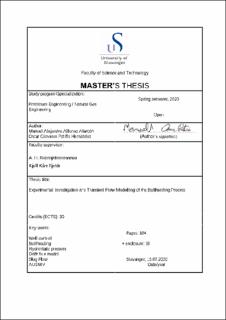| dc.contributor.author | Alfonso, Manuel Alejandro | |
| dc.contributor.author | Patino, Oscar Giovanni | |
| dc.date.accessioned | 2020-10-19T13:24:58Z | |
| dc.date.available | 2020-10-19T13:24:58Z | |
| dc.date.issued | 2020-07-15 | |
| dc.identifier.uri | https://hdl.handle.net/11250/2683701 | |
| dc.description | Master's thesis in Petroleum engineering | en_US |
| dc.description.abstract | The main objective of this thesis was to design and study a physical laboratory scale model, to simulate a kick and push it through the bullheading method. The air bubble was injected in a cylindrical loop system filled with water acting as a multiphase flow system. In drilling operations this is imperative to handle or prevent the migration effect of kicks through the Surface.
This study was focused on the implementation of the bullheading method applied in laboratory, with gas bubble injected into a Newtonian fluid filled system. The main goal was the circulation of the gas using liquid at a downward direction to push it to its injection position using four different flow rate tests. The difference in each test lies in the progressive increase in the liquid rate, which gradually shortens the time it takes for the gas to return to the site where it was injected. The amount of gas induced was monitored in all the four tests by using a reference height in the pipe, to decrease calculation variations for the gas rate results.
The hydrostatic pressure of the system was monitored with the use of PASCO Capstone equipment for the measurement of the absolute pressure. The gas rate was calculated with the pressure drop in a time interval when the sensor perceives the pass of the bubble and then when it only perceives liquid as an indicator of constant pressure in the sensor reading.
The average speed of the bubble was determined with the distance and the time it took to pass between the Top and Mid pressure sensors when bullheading. The increase in liquid rates produced an increase in the average velocity of the gas, decreasing the time it takes for the bubble to pass through the two sensors in each of the flow liquid rates.
The gas and liquid rates were determined in the laboratory. The same was the geometries of the experimental scale model and other initial conditions these were used as inputs for the numerical model and thus obtaining the average gas velocity. On this study, gas velocity was the parameter to be compared with experimental results and simulation due to the initial conditions of the flow model. It creates a different scenario than the real one making futile any further comparison for the moment. The numerical model conditions differed from the experimental model, due to the size of the bubble obtained from the numerical simulation which was different from the bubble injected experimentally. Because the physical parameters are dependents of the bubble area e.g. pressure, volume, etc.
The bullheading experiment allowed the visualization of the Slug flow and Dispersed flow pattern characteristic for the vertical multiphase flow patterns at a range of superficial gas and liquid velocities. | en_US |
| dc.language.iso | eng | en_US |
| dc.relation.ispartofseries | Masteroppgave/UIS-TN-IEP/2020; | |
| dc.subject | petroleumsteknologi | en_US |
| dc.subject | produksjonsteknologi | en_US |
| dc.subject | petroleum engineering | en_US |
| dc.title | Experimental Investigation and Transient Flow Modelling of the Bullheading Process | en_US |
| dc.type | Master thesis | en_US |
| dc.subject.nsi | VDP::Teknologi: 500::Berg‑ og petroleumsfag: 510::Petroleumsteknologi: 512 | en_US |
